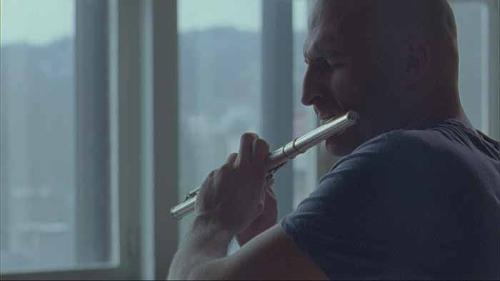.jpg)
The second stand-alone Sea Art Festival in Busan creates a site of imaginary fantasy. Thirty-four sturdy, large artworks (sculptures in another life) by both 'invited' and ‘participating’ artists from half-and-half Korea and elsewhere are spread along the half-moon of carpet-smooth, very yellow sand of Songdo Beach. This is surrounded by motley buildings clinging to the lower slopes of steep tree-covered mountains (Bu-san means many mountains) dipping down to sheltered waters hosting a number of large, concrete (presumably) red and yellow dolphins leaping out of the water, a huge whale’s head and tail, and a very fancy diving platform, before our eye leads out to a horizon jammed with cargo freighters, like the back-drop to the action before us. The landward side of this dream-place has concreted rocks at the central hillside, emulating the real ones to each side, above a boardwalk lined by poodle-clipped pine trees. It is a natural theatre or film set, inviting fun-focused activity for its audience of locals (retirees passing the time), Korean visitors (families happily playing ball, taking photographs, and strolling around), and we visiting spectators.
My thoughts turned to Disney fantasies; to the highly fanciful 1983 Stravinsky Fountain outside the Pompidou Centre in Paris by Jean Tinguely and Niki de Saint-Phalle; and to Anne Zahalka’s 1989 photographic series, Bondi – Playground of the Pacific of similar imaginings. But perhaps more relevant in Busan is Choi Jeong-hwa who makes simulacra of nature: huge inflated plastic flowers, for example, in bright fluorescent colours. He says that the ‘nature’ he creates is more real than the nature of the mountains and forests, still revered in traditional Korea. His comments have added poignancy in the context of Songdo Beach.
The artworks for this exhibition, spread along the yellow sand, with a few anchored on the boardwalk above and two in the sea, are players on this fantasy set. To take the metaphor one step further: the site has the feel of being in the movie The Truman Show, with all of us obligingly agreeing to the make-believe that we are dealing with issues (environmental or other) pertinent to any horrors that lie beyond this arena.
This long introduction is necessary because this site is so central to the art displayed on its stage. One of the artists, Tallur L.N., said Songdo Beach was literally challenging through having to understand the additional elements of the wind, tides and sand. The two works sited in the sea itself had both struggled with the demands of building a large Choppy Castle in the water (the winner of the grand prize, by Eun-Phil Cho), and (the winner of the prize two years ago, Italian Matteo Berra) used the tides cleverly to make a bamboo "flower-petal" poles fall (open) and rise (close).
Beyond these, the centrally placed artworks had little capacity to create their own physical environment, but instead competed with both the place and with the next piece a few metres along. Group exhibitions in galleries provide the neutrality of walls that these works lacked. It is different too to Sculpture by the Sea, taking the viewer on a walk through a changing environment. Even more different, the Echigo Tsumari Triennial in Japan has artworks sited through a couple of provinces which require a few days driving between them.
Here it is all before you. It forces accessibility. Even more serious intentions, alluded to by the artists in the accompanying texts, play second fiddle to their physical presence on the sand. The ones that worked best for me take into account some human dimension and some real relation to the sea. Canadians Coryn Kempster and Julia Jamrozik make a pile of beach toys, like a plastic mountain of fun, Inflatable Culture. Indian Tallur L.N. makes a monument to the cycles of life in his carved boulder by the edge of the water, Karma Yoga: The Therapy Machine, and Thai artist group Sanitas Studio made Equilibrium, large rubber skittles in the shape of Korean celadon jars, whose serious intent about the beach’s history watching over Korea’s highly scarred past, went right over the kids who loved jumping on them. And New York / Korean duo June Kim and Cheyeon Park’s reference to the past view of the beach in large photography, again with the intent of memory, titled You are Here, encouraged new photographs by passers-by commemorating their visit to the beach in front of it. Konstantin Dimopoulos had less luck. His inflated free-flying birds, called Birdcloud, had to be caged on the beach, due, apparently, to them dropping to earth if the wind failed, and children making off with them. It was a problem for his work, but a triumph for local engagement – long may that reign.
The Sea Art Festival began as part of the Busan Biennale, which still has oversight of both events, but now is held in the intervening year both for spreading the fun, and to make each more clearly independent.
One of the joys of a local festival like this, with the artistic director, Tae-Won Park, being a local sculptor, and be-suited lines of government officials happily taking part, is that this too takes on its own momentum. If there is a growing international discussion on the type and role of biennale festivals, then this popular, highly accessible event has its place. The Deputy Mayor declared the show open with a shout of triumph, a drum roll, streamers and clouds of smoke. The celebratory nature of the theatre continued. Ron Robertson-Swann there representing Sculpture by the Sea, suggested we need to lift our game in this department.
Songdo Beach is a construct. The 2013 Festival celebrates 100 years of it being a ‘beach’. We were told its fortunes had ebbed and flowed. As with the Echigo Tsumari Triennial, art is a means used by local government to breathe life into a site that hopes to regain its past glory. And it works. The elderly citizens watched with keen interest as the works were erected on the sand. One woman, beaming, said how she had learnt about the art from the labels, and thought it was all "wonderful". She was the best advocate any artists or supporters of an event like this might desire.












